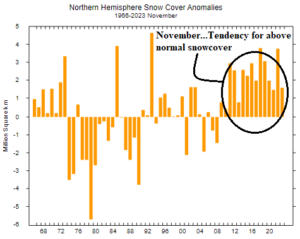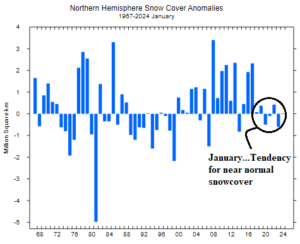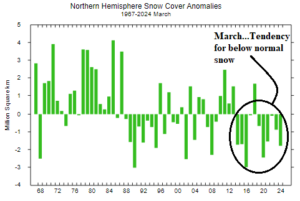Tropical Africa Becomes Soaking Wet and Emits Strong Tropical Waves into the Atlantic
09/04/2024, 11:04 am EDTDeep Tropics Starved for Mid-Atmosphere Moisture
09/06/2024, 8:48 am EDTDiscussion: As the polar region turns sharply colder due to loss of sunlight mid-to-late autumn, cold air is swept across an increase in open ocean water (due to a constricting polar ice cap) that leads to advection snows bringing above normal snowfall to the northern continents most notably Northern Russia. The development is persistent during the past 11-12 seasons beginning as early as October (Fig. 1) and continuing in November (Fig. 2). The recent increase in northern latitude snow cover enables early season cold air masses to form, most notably in North-central Asia.
However, unlike the past century when early season abundant snow cover nearly guaranteed a cold start to mid-latitude winter (as snow cover shifted farther south), the lack of southern penetration into the mid-latitudes during early-to-middle winter (Fig. 3-4) during the past decade generally prevents cold air mass in the middle latitudes. Instead, milder westerly marine influence from the Pacific becomes dominant yielding a warmer than normal climate much of the time in the U.S. A similar influence from the North Atlantic across Europe is notable.
Generally, February and March snow cover during recent years also remains below normal, favoring a milder climate for the middle latitudes (Fig. 5-6).


Fig. 1-2: Rutgers Snow Lab monthly snow cover anomalies for the northern hemisphere during October and November.


Fig. 3-4: Rutgers Snow Lab monthly snow cover anomalies for the northern hemisphere during December and January.


Fig. 5-6: Rutgers Snow Lab monthly snow cover anomalies for the northern hemisphere during February and March.
